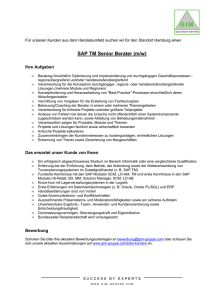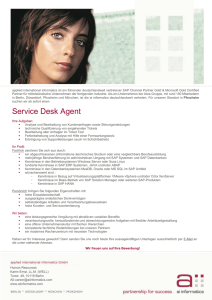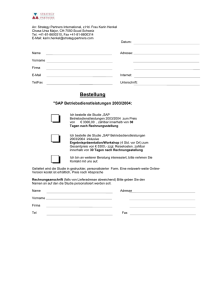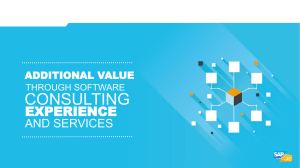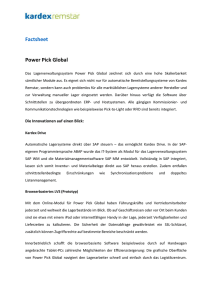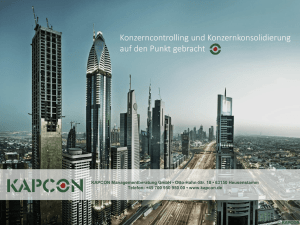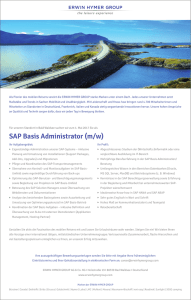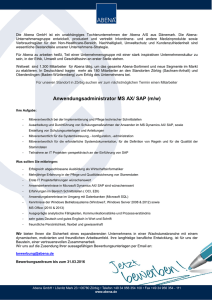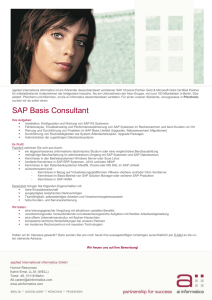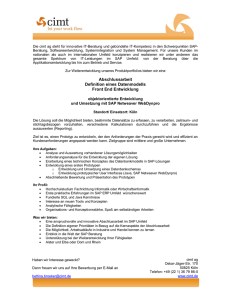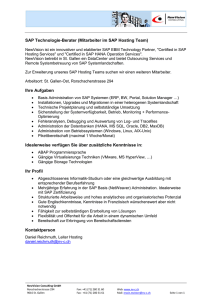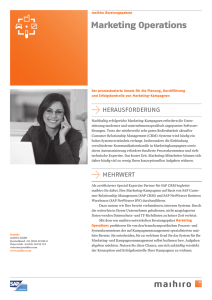Cross plant planning
Werbung
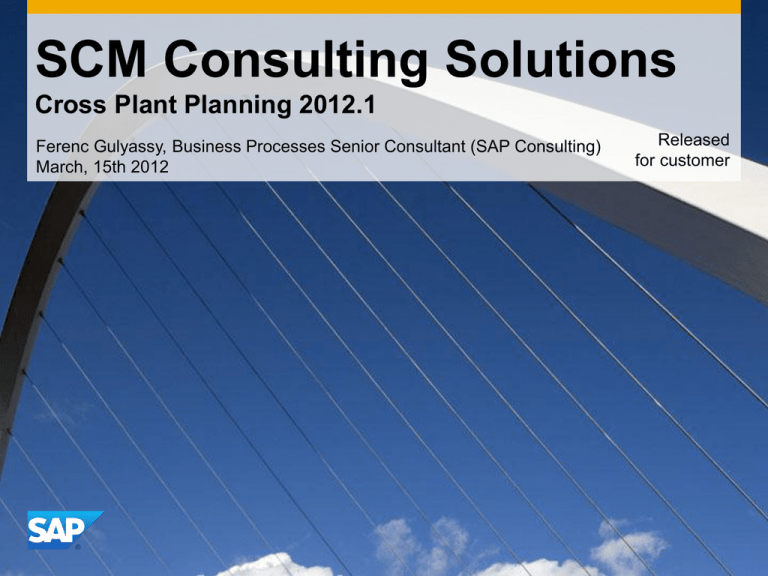
SCM Consulting Solutions Cross Plant Planning 2012.1 Ferenc Gulyassy, Business Processes Senior Consultant (SAP Consulting) March, 15th 2012 Released for customer Agenda 1. 2. 3. 4. The challenge: Cross plant planning The solution: The cross-plant planning solution of SAP Details on the cross-plant planning solution of SAP Differences to the SAP standard © 2011 SAP AG. All rights reserved. Customer 2 The challenge: Cross plant planning Many enterprises are facing the following problems: Remaining stocks are causing expensive scrapping activities Stock on-hand in one plant could be used to cover demand in another plant Cross-plant monitoring of stock on-hand and its usage requires high manual effort – the risk of wrong decisions is high Missing automated algorithms might be the reason for not using existing and available stocks on-hand © 2011 SAP AG. All rights reserved. Customer 3 Agenda 1. 2. 3. 4. The challenge: Cross plant planning The solution: The cross-plant planning solution of SAP Details on the cross-plant planning solution of SAP Differences to the SAP standard © 2011 SAP AG. All rights reserved. Customer 4 The solution: The cross-plant planning solution of SAP Questions and answers concerning the cross plant planning solution of SAP What are the prerequisites on the customer side? Usage of SAP ECC 6.0 An EhP is not mandatory No SCM APO system is required What are the advantages of cross plant planning? Identification of slow-moving items Identification of materials that are available-to-transfer Automatic creation of stock transfer purchase orders Is the cross plant planning a modification of the SAP standard? It is an add-on and no modification Are customizing settings required for the usage of cross plant planning? No customer specific settings are required How much effort is required for the implementation? The consulting solution can be installed in a day and is immediately available How much does cross-plant planning cost? Please send a request to the contacts mentioned at the end of this presentation © 2011 SAP AG. All rights reserved. Customer 5 Objectives of the SAP cross plant planning The aim is the automated cross plant planning and allocation of available stocks onhand: Reduction of slow-moving items Identification of stocks available-to-transfer Automatic creation of stock transfer purchase orders Reduction of external procurement proposals that could be replaced by stock transfer purchase orders Creation of updated MRP lists © 2011 SAP AG. All rights reserved. Customer 6 Agenda 1. 2. 3. 4. The challenge: Cross plant planning The solution: The cross-plant planning solution of SAP Details on the cross-plant planning solution of SAP Differences to the SAP standard © 2011 SAP AG. All rights reserved. Customer 7 Details on the cross-plant planning solution of SAP © 2011 SAP AG. All rights reserved. Customer 8 Agenda 1. 2. 3. 4. The challenge: Cross plant planning The solution: The cross-plant planning solution of SAP Details on the cross-plant planning solution of SAP Differences to the SAP standard © 2011 SAP AG. All rights reserved. Customer 9 Differences to the SAP standard The following differences compared to the ERP system have to be mentioned: Automated reduction of slow-moving items Automated creation of stock transfer purchase orders based on existing demands Reduction of external procurement proposals that can be replaced by stock transfer purchase orders Creation of updated MRP lists that contain the previously created stock transfer purchase orders © 2011 SAP AG. All rights reserved. Customer 10 Where can I get more information on SCM CS? Go to SAP service marketplace and search for note 1493943! Or ask for more information: Marc Hoppe Consulting Manager SCM SAP Consulting SAP Deutschland AG & Co. KG Großer Grasbrook 17 20457 Hamburg [email protected] © 2011 SAP AG. All rights reserved. Ferenc Gulyássy Business Processes Senior Consultant SCM SAP Consulting SAP Deutschland AG & Co. KG Homberger Straße 25 40882 Ratingen [email protected] Customer 11 © 2011 SAP AG. Alle Rechte vorbehalten. Weitergabe und Vervielfältigung dieser Publikation oder von Teilen daraus sind, zu welchem Zweck und in welcher Form auch immer, ohne die ausdrückliche schriftliche Genehmigung durch SAP AG nicht gestattet. In dieser Publikation enthaltene Informationen können ohne vorherige Ankündigung geändert werden. Die von SAP AG oder deren Vertriebsfirmen angebotenen Softwareprodukte können Softwarekomponenten auch anderer Softwarehersteller enthalten. Microsoft, Windows, Excel, Outlook, und PowerPoint sind eingetragene Marken der Microsoft Corporation. IBM, DB2, DB2 Universal Database, System i, System i5, System p, System p5, System x, System z, System z10, System z9, z10, z9, iSeries, pSeries, xSeries, zSeries, eServer, z/VM, z/OS, i5/OS, S/390, OS/390, OS/400, AS/400, S/390 Parallel Enterprise Server, PowerVM, Power Architecture, POWER6+, POWER6, POWER5+, POWER5, POWER, OpenPower, PowerPC, BatchPipes, BladeCenter, System Storage, GPFS, HACMP, RETAIN, DB2 Connect, RACF, Redbooks, OS/2, Parallel Sysplex, MVS/ESA, AIX, Intelligent Miner, WebSphere, Netfinity, Tivoli und Informix sind Marken oder eingetragene Marken der IBM Corporation. Linux ist eine eingetragene Marke von Linus Torvalds in den USA und anderen Ländern. Adobe, das Adobe-Logo, Acrobat, PostScript und Reader sind Marken oder eingetragene Marken von Adobe Systems Incorporated in den USA und/oder anderen Ländern. Oracle und Java sind eingetragene Marken von Oracle und/oder ihrer Tochtergesellschaften. HTML, XML, XHTML und W3C sind Marken oder eingetragene Marken des W3C®, World Wide Web Consortium, Massachusetts Institute of Technology. SAP, R/3, SAP NetWeaver, Duet, PartnerEdge, ByDesign, SAP BusinessObjects Explorer, StreamWork und weitere im Text erwähnte SAP-Produkte und Dienstleistungen sowie die entsprechenden Logos sind Marken oder eingetragene Marken der SAP AG in Deutschland und anderen Ländern. Business Objects und das Business-Objects-Logo, BusinessObjects, Crystal Reports, Crystal Decisions, Web Intelligence, Xcelsius und andere im Text erwähnte Business-Objects-Produkte und Dienstleistungen sowie die entsprechenden Logos sind Marken oder eingetragene Marken der Business Objects Software Ltd. Business Objects ist ein Unternehmen der SAP AG. Sybase und Adaptive Server, iAnywhere, Sybase 365, SQL Anywhere und weitere im Text erwähnte Sybase-Produkte und -Dienstleistungen sowie die entsprechenden Logos sind Marken oder eingetragene Marken der Sybase Inc. Sybase ist ein Unternehmen der SAP AG. Alle anderen Namen von Produkten und Dienstleistungen sind Marken der jeweiligen Firmen. Die Angaben im Text sind unverbindlich und dienen lediglich zu Informationszwecken. Produkte können länderspezifische Unterschiede aufweisen. Die in dieser Publikation enthaltene Information ist Eigentum der SAP. Weitergabe und Vervielfältigung dieser Publikation oder von Teilen daraus sind, zu welchem Zweck und in welcher Form auch immer, nur mit ausdrücklicher schriftlicher Genehmigung durch SAP AG gestattet. UNIX, X/Open, OSF/1 und Motif sind eingetragene Marken der Open Group. Citrix, ICA, Program Neighborhood, MetaFrame, WinFrame, VideoFrame und MultiWin sind Marken oder eingetragene Marken von Citrix Systems, Inc. © 2011 SAP AG. All rights reserved. Customer 12
